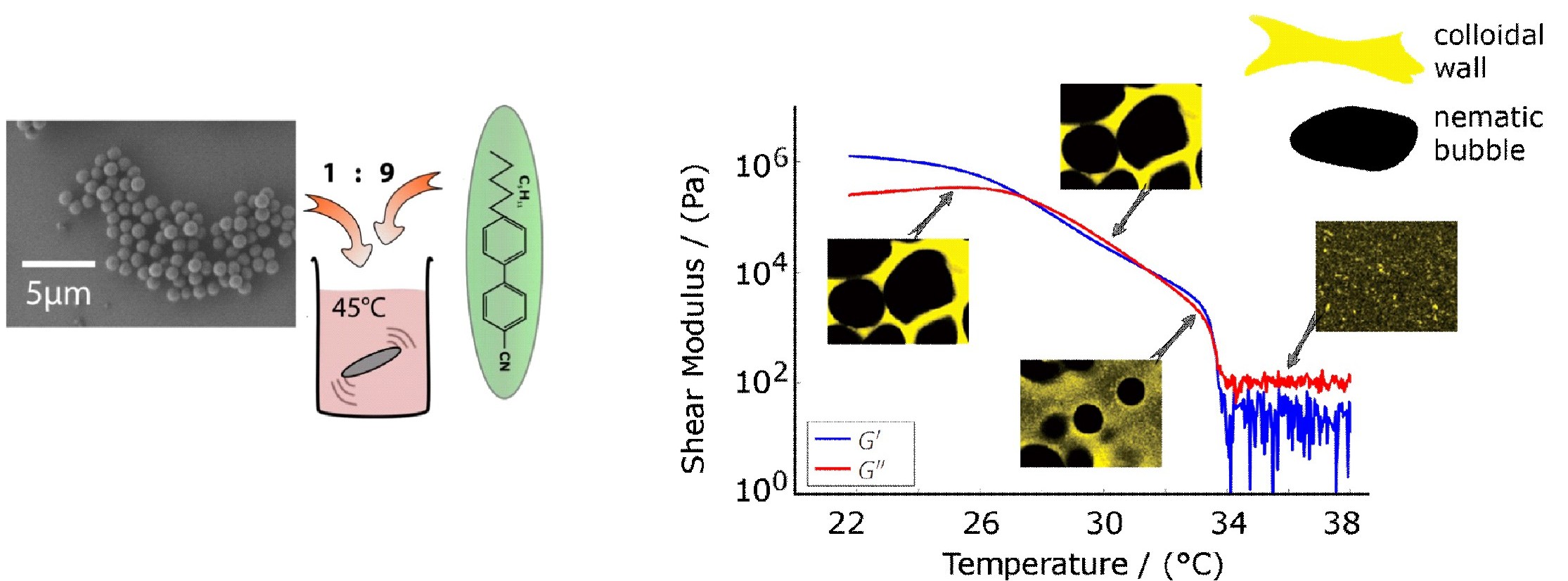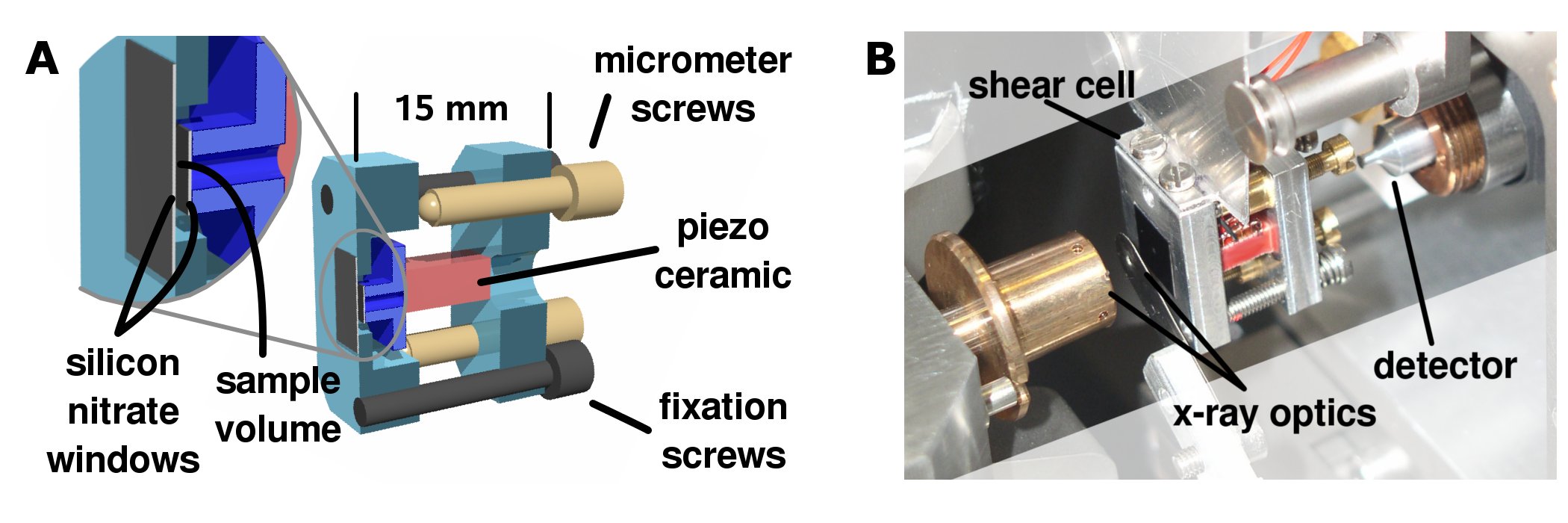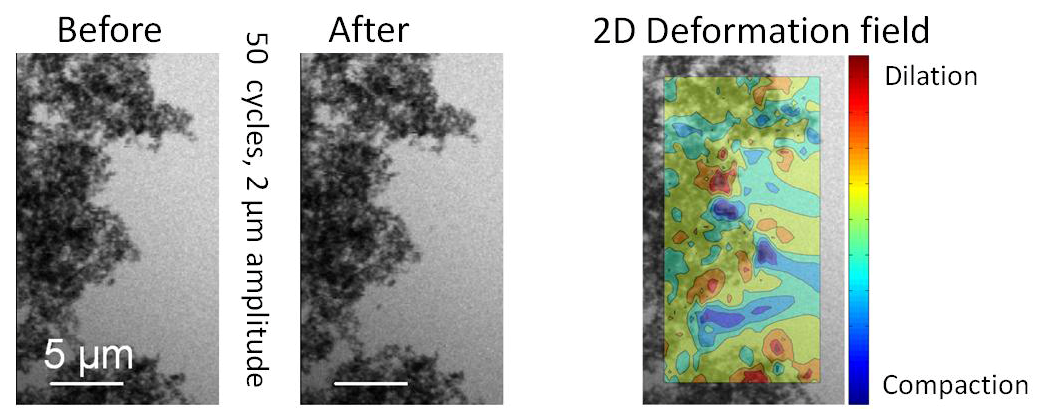Research - Colloids
Mechanical properties of colloidal aggregates
Colloidal suspensions are widely used as experimental systems for studying phase transitions as well as entropic, electrostatic, and hydrodynamic interactions. For these purposes, mostly monodisperse, bidisperse, or slightly polydisperse colloids are employed. Colloids often aggregate during the production process or after longer periods of storage. Aggregation can arise from an increase in particle concentration or from prevailing attractive interactions between particles. Despite the technical relevance, growth and aggregation of colloids in suspension are still poorly understood. One major reason is that data obtained by classical (predominantly scattering) methods cannot be interpreted unambiguously due to polydispersity and turbidity. |
 
|
Colloidal aggregates tested via nano indentation and simultaneous 3D imaging:
In this work we investigate the mechanical properties of aggregates made from mono-disperse poly-methyl methacrylate (PMMA) particles (diameter: 1.6 μm) via nano indentation in combination with confocal microscopy. In doing so the bare mechanical data are complemented by 3D coordinates of all particles within the aggregate as well as their individual displacements during the indentation. This information is used to identify reorganization processes and calculate the average strain field. We show that in case of dense amorphous aggregates the strain field is in reasonable agreement with the predictions from continuum theories. In semicrystalline assemblies heterogeneities and generation of dislocation defects are observed which is in accordance with the behavior of atomic crystal. As a consequence the measured force-depth curves can be quantitatively analyzed with the theory of Oliver and Pharr that is usually used for indentation of atomic matter such as metals, ceramics and polymers. The extracted values for hardness and effective elastic modulus represent average values characteristic of the aggregate. Beside to the variation in aggregate structure the influence of particle bonds is tested by introducing polystyrene (PS) between the particles.

- M. Roth, C. Schilde, P. Lellig, A. Kwade, and G. K. Auernhammer;
Colloidal aggregates tested via nanoindentation and simultaneous 3D imaging;
Eur. Phys. J. E 35, 9801 (2012), DOI 10.1140/epje/i2012-12124-8. - M. Roth, C. Schilde, P. Lellig, A. Kwade, G. K. Auernhammer;
Simultaneous nanoindentation and 3D imaging on semi-crystalline colloidal films;
Chem. Lett. 41 (10), 1110-1112 (2012). - L. Zhang, M. D'Acunzi, M. Kappl, G. K. Auernhammer, D. Vollmer, C. M. van Kats, and A. van Blaaderen;
Hollow Silica Spheres: Synthesis and Mechanical Properties;
Langmuir, 25, (2009), 2711-2717.
Viscoelastic rheology of colloid-liquid crystal composites:
In suspensions of polymeric colloids in liquid crystals (LCs), solvent-particle interactions dominate and can be changed when the LC undergoes phase transition from isotropic to nematic. In case of poly-methyl methacrylate colloids and 4-pentyl-4-cyanobiphenyl (5CB), cooling through the isotropic-nematic phase transition results in a cellular network. The network formation is accompanied by a strong evolution of the mechanical properties. Until now, the mechanical response of the gel was attributed to the elastic interactions of the LC with the colloids. We used a homemade piezorheometer to measure the complex shear modulus of the sample in parallel plate geometry. Since the applied strains are very small, only the linear viscoelastic regime was tested. This limit guarantees a high degree of reproducibility. We gained insight into the underlying processes by measuring the frequency response for the whole cooling process. Temperature and frequency showed a strong correlation allowing for a superposition of the frequency spectra to form a single master curve similar to time-temperature-superposition. We propose that this superposition behavior is connected to the thermodynamics of the isotropic-nematic phase transition of 5CB located in the network walls. Additional experimental observations, such as hysteresis effects, support this assumption Similar effects have been observed by dielectric spectroscopy.

- Roth, M., M. D'Acunzi, D. Vollmer, and G. K. Auernhammer;
Viscoelastic rheology of colloid-liquid crystal composites;
J. Chem. Phys. 132, 124702 (2010).
Time-resolved x-ray microscopy of nanoparticle aggregates under oscillatory shear
X-ray microscopy is an imaging technique which allows for a spatial resolution below 35 nm. We used it to investigate shear-induced structural dynamics by inserting a piezo actuator-driven shear cell into the focal plane of a scanning transmission x-ray microscope (STXM, Paul Scherrer Institute, Villigen, Switzerland).

We investigate shear-induced reorganization aggregates of 50 nm sized magnetite particles embedded in a polymer melt. Depending on the amplitude of the applied oscillatory shear, either the aggregates strongly move and reorganize (large amplitudes) or just slightly deform (low amplitudes). We correlated the deformations of the aggregates with structure (as visible in the STXM) and compare our results to experiments with nonmagnetic colloids.

- G. K. Auernhammer, K. Fauth, B. Ullrich, J. Zhao, M. Weigand and D. Vollmer;
Time-resolved X-ray microscopy of nanoparticle aggregates under oscillatory shear;
J. Synchrotron Rad., 16, (2009), 307-309.

